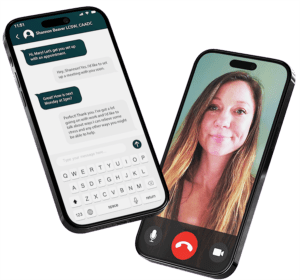Prescribing with Connection

By: Lynne Garvey, DNP, CRNP, PMHNP-BC, RN
The Rise and Value of Telehealth in Psychiatric Care
The Rise and Value of Telehealth in Psychiatric Care
The way we deliver mental health care has transformed in recent years, and one of the most impactful changes has been the rise of telehealth. Simply put, telehealth refers to the use of secure video or phone technology to provide healthcare services remotely. In psychiatry, this includes virtual visits where patients meet with a licensed provider to discuss symptoms, manage medications, and receive support—all without needing to visit an office in person.
As a psychiatric prescriber, I’ve witnessed how telehealth prescribing has expanded access, reduced barriers, and helped people stay connected to care. What was once an alternative option has now become a trusted, effective method of delivering psychiatric treatment.
Real-life strategy to reach your goals.
How Telehealth Became Standard in Mental Health
We strive for diversity across the globe
Telehealth technology has been available for over a decade, but it wasn’t widely used in psychiatric medication management until the onset of the COVID-19 pandemic in 2020. At that time, the healthcare system faced an urgent need to provide care while maintaining safety and distancing. Regulatory bodies responded quickly by relaxing restrictions around virtual care, and many insurers expanded coverage for telehealth services—including psychiatric evaluations and prescribing.
These changes revealed what many mental health professionals suspected: psychiatric care can be just as effective when delivered virtually. Providers found that they could maintain strong therapeutic relationships and manage medications responsibly through video visits, and patients appreciated the ease and flexibility of accessing care from home. Today, telehealth remains a permanent part of the healthcare landscape, helping millions continue their treatment with less disruption and more convenience.

Real-life strategy to reach your goals.
The Role of a Prescriber in Telehealth
Real-life strategy to reach your goals.
In a telehealth setting, the responsibilities of psychiatric prescribers remain the same: assess mental health symptoms, establish diagnoses, prescribe medications, and monitor treatment over time. What changes is the format—not the quality—of those interactions. A well-structured virtual session allows for thoughtful clinical conversations, clear medication education, and meaningful check-ins about progress and side effects.
As a prescriber, I focus on ensuring that each telehealth appointment feels just as intentional and supportive as an in-person visit. I review symptoms, explore what’s working (or not working), and partner with the patient to make informed decisions about treatment. Whether someone is just starting medication or adjusting an existing regimen, telehealth enables that process to continue without interruption.
Real-life strategy to reach your goals.
We strive for diversity across the globe
How I Connect with Patients Virtually
Building meaningful connection in a virtual setting is not only possible—it’s essential. When I meet with patients through telehealth, I aim to bring the same level of warmth, presence, and attentiveness that I would in a face-to-face session. I begin each appointment by checking in not just on symptoms, but on how the patient is feeling overall—mentally, emotionally, and physically. This opens the door to a more holistic conversation and helps establish trust from the start.
Even through a screen, I pay close attention to verbal and nonverbal cues—tone of voice, facial expression, body language—all of which offer important insight into how someone is truly doing. I use reflective listening and open-ended questions to encourage deeper dialogue and to ensure that patients feel seen and heard.
I also make sure that patients understand they are active participants in their treatment. Whether we’re discussing medication options, tracking progress, or exploring next steps, I work to create a collaborative space where patients feel safe, respected, and empowered.
Key Benefits of Telehealth Psychiatric Prescribing
Real-life strategy to reach your goals.
1. Expanded Access to Care
Telehealth makes it possible for patients in rural areas, small towns, or underserved communities to access qualified psychiatric care that might not be available locally. In places where mental health providers are scarce or where long travel distances create a barrier, telehealth offers a direct line to care without the need to leave your home. This expanded access helps bridge gaps in the healthcare system and ensures that location doesn’t determine the quality or consistency of your treatment.
2. Greater Flexibility and Convenience
Telehealth reduces the stress and time commitment often associated with in-person visits. Patients can schedule appointments during lunch breaks, before work, or after school hours, without needing to travel or arrange childcare. This flexibility supports treatment continuity and reduces the likelihood of missed appointments.
3. Increased Comfort and Therapeutic Openness
Meeting from the comfort of home can ease anxiety and help patients feel more relaxed during appointments. This sense of familiarity often leads to greater openness, making it easier to discuss personal topics and explore emotions. For individuals who may feel overwhelmed in clinical environments, telehealth offers a more approachable setting for building a strong therapeutic relationship.
4. Lowering Barriers to Starting Mental Health Care
Telehealth can make it easier for people to begin treatment—especially those who’ve delayed seeking help due to stigma, fear, or uncertainty. The ability to connect privately from home can reduce feelings of vulnerability and make the process feel more accessible. For many, starting virtually removes the pressure of walking into a clinic and helps them take that important first step toward healing.
5. Improved Follow-Up and Medication Monitoring
Frequent check-ins are key to effective medication management. Telehealth makes it easier to schedule short, focused follow-ups to review how a medication is working, address side effects, and adjust dosages when needed—without unnecessary delays.
Final Thoughts
Telehealth has redefined how we connect in psychiatric care—and in many ways, it has strengthened the provider-patient relationship. As a psychiatric prescriber, I’ve found that virtual visits not only maintain the quality of care but enhance it by making support more consistent, accessible, and responsive to the demands of real life.
If you’re considering starting or continuing psychiatric care, telehealth may be a valuable option for you. It’s more than a convenient alternative—it’s a reliable, compassionate way to stay engaged in your mental health journey, no matter where you are.
Real-life strategy to reach your goals.
We strive for diversity across the globe
Real-life strategy to reach your goals.
Related Posts


